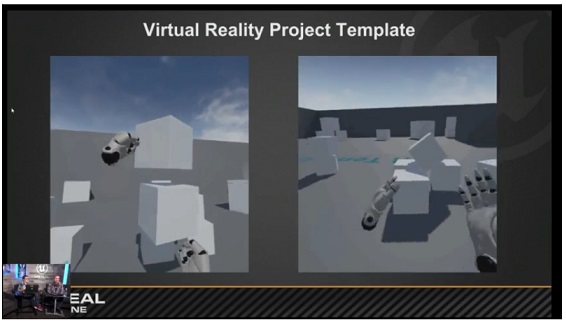During Epic Games’s live stream for Unreal Engine there was a breakdown of what users will be able to do and experience when the latest version of the engine is released, and expands more on the preview that was released.
Technical Director, Mike Fricker, joined Community Manager, Alexander Paschall, were on the live stream discussing all of the new features coming with the full release of Unreal Engine 4.13 at the end of the month. There was a pretty large amount of updates that will be added to UE4.13, most of which concentrate on the animation abilities.
The first feature that was talked about was VR project templating, which is said to make those who are starting new projects get into it easily, as it helps with basic movement and animation. There are two examples of this, which are teleportation as a means of movement, as well as using motion controllers to pick up and move things, playing with physics. It was expanded on in the questions and answers section at the end of the stream, and it was said that it supports both desktop and mobile, as well as PlayStation VR, depending on which level you use. Level one is best for Desktop, and level two is “best suited to Gear VR because it doesn’t require a controller for teleporting around”.
Rendering was another big part of the list of VR improvements, as it was said that “depending on your game, there is up to 10% faster VR rendering” – particularly PlayStation 4.
After these two pretty major improvements, there was a list of smaller details. This includes: texture and vertex shading, which by using what was jokingly referred to as “lasers” or “sabers”, users can add textures in a simple and accessible way; a foliage painting tool, which “if you’re using a Vive or Oculus Touch dev kit, there’s a button you can hold to erase or paint”; a colour picker, which is familiar already and has been used in various titles; a transform gizmo, and it was commented that “the rotation was a little bit of a disaster before but it’s better now”; there is now a flashlight in VR as well as the ability to make screenshots; and a widget interaction component that gives developers full control over how things get touched.
One last detail that was talked about was automatic entry into VR, which has already been spoken about but there is confirmation of its inclusion.
Fricker and Paschall commented that there will be much more to be developed, some of which will spill over into later versions: “We’re experimenting with different types of interactions in VR, trying to make it more natural… some one-to-one stuff, but that’s for the future.”
For more on the latest news on Unreal Engine 4.13, as well as all the latest news and updates in the world of VR, check back with VRFocus.















